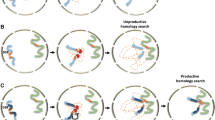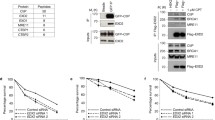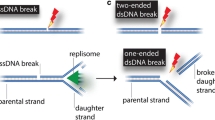Abstract
DNA double-strand breaks are genotoxic lesions whose repair can be templated off an intact DNA duplex through the conserved homologous recombination (HR) pathway. Because it mainly consists of a succession of non-covalent associations of molecules, HR is intrinsically reversible. Reversibility serves as an integral property of HR, exploited and tuned at various stages throughout the pathway with anti- and pro-recombinogenic consequences. Here, we focus on the reversibility of displacement loops (D-loops), a central DNA joint molecule intermediate whose dynamics and regulation have recently been physically probed in somatic S. cerevisiae cells. From homology search to repair completion, we discuss putative roles of D-loop reversibility in repair fidelity and outcome.




Similar content being viewed by others
References
Adzuma K (1992) Stable synapsis of homologous DNA molecules mediated by the Escherichia coli RecA protein involves local exchange of DNA strands. Genes Dev 6:1679–1694
Anand R, Beach A, Li K, Haber J (2017) Rad51-mediated double-strand break repair and mismatch correction of divergent substrates. Nature 544:377–380. https://doi.org/10.1038/nature22046
Argueso JL, Westmoreland J, Mieczkowski PA, Gawel M, Petes TD, Resnick MA (2008) Double-strand breaks associated with repetitive DNA can reshape the genome. Proc Natl Acad Sci USA 105:11845–11850. https://doi.org/10.1073/pnas.0804529105
Bell JC, Kowalczykowski SC (2016) RecA: regulation and mechanism of a molecular search engine. Trends Biochem Sci 41:491–507. https://doi.org/10.1016/j.tibs.2016.04.002
Bordelet H, Dubrana K (2019) Keep moving and stay in a good shape to find your homologous recombination partner. Curr Genet 65:29–39. https://doi.org/10.1007/s00294-018-0873-1
Branzei D, Szakal B (2017) Building up and breaking down: mechanisms controlling recombination during replication. Crit Rev Biochem Mol Biol 52:381–394. https://doi.org/10.1080/10409238.2017.1304355
Brown MS, Grubb J, Zhang A, Rust MJ, Bishop DK (2015) Small Rad51 and Dmc1 complexes often co-occupy both ends of a meiotic DNA double strand break. PLoS Genet 11:e1005653. https://doi.org/10.1371/journal.pgen.1005653
Buzovetsky O, Kwon Y, Pham NT, Kim C, Ira G, Sung P, Xiong Y (2017) Role of the Pif1-PCNA complex in Pol delta-dependent strand displacement DNA synthesis and break-induced replication. Cell Rep 21:1707–1714. https://doi.org/10.1016/j.celrep.2017.10.079
Bzymek M, Thayer NH, Oh SD, Kleckner N, Hunter N (2010) Double Holliday junctions are intermediates of DNA break repair. Nature 464:937–941. https://doi.org/10.1038/nature08868
Chan JE, Kolodner RD (2011) A genetic and structural study of genome rearrangements mediated by high copy repeat Ty1 elements. PLoS Genet 7:e1002089. https://doi.org/10.1371/journal.pgen.1002089
Coic E, Martin J, Ryu T, Tay SY, Kondev J, Haber JE (2011) Dynamics of homology searching during gene conversion in Saccharomyces cerevisiae revealed by donor competition. Genetics 189:1225–1233. https://doi.org/10.1534/genetics.111.132738
Crickard JB, Greene EC (2019) Helicase mechanisms during homologous recombination in Saccharomyces cerevisiae. Annu Rev Biophys. https://doi.org/10.1146/annurev-biophys-052118-115418
Danilowicz C, Yang D, Kelley C, Prevost C, Prentiss M (2015) The poor homology stringency in the heteroduplex allows strand exchange to incorporate desirable mismatches without sacrificing recognition in vivo. Nucleic Acids Res 43:6473–6485. https://doi.org/10.1093/nar/gkv610
Danilowicz C, Hermans L, Coljee V, Prevost C, Prentiss M (2017) ATP hydrolysis provides functions that promote rejection of pairings between different copies of long repeated sequences. Nucleic Acids Res 45:8448–8462. https://doi.org/10.1093/nar/gkx582
Deem A, Barker K, VanHulle K, Downing B, Vayl A, Malkova A (2008) Defective break-induced replication leads to half-crossovers in Saccharomyces cerevisiae. Genetics 179:1845–1860. https://doi.org/10.1534/genetics.108.087940
Elango R, Sheng Z, Jackson J, DeCata J, Ibrahim Y, Pham NT, Liang DH, Sakofsky CJ, Vindigni A, Lobachev KS, Ira G, Malkova A (2017) Break-induced replication promotes formation of lethal joint molecules dissolved by Srs2. Nat Commun 8:1790. https://doi.org/10.1038/s41467-017-01987-2
Fasching CL, Cejka P, Kowalczykowski SC, Heyer WD (2015) Top3-Rmi1 dissolve Rad510-mediated D loops by a topoisomerase-based mechanism. Mol Cell 57:595–606. https://doi.org/10.1016/j.molcel.2015.01.022
Gangloff S, Soustelle C, Fabre F (2000) Homologous recombination is responsible for cell death in the absence of the Sgs1 and Srs2 helicases. Nat Genet 25:192–194
Heyer WD (2015) Regulation of recombination and genomic maintenance. Cold Spring Harb Perspect Biol 7:a016501. https://doi.org/10.1101/cshperspect.a016501
Hoang ML, Tan FJ, Lai DC, Celniker SE, Hoskins RA, Dunham MJ, Zheng YX, Koshland D (2010) Competitive repair by naturally dispersed repetitive DNA during non-allelic homologous recombination. PLoS Genet 6:e1001228. https://doi.org/10.1371/journal.pgen.1001228
Hong S, Sung YJ, Yu M, Lee M, Kleckner N, Kim KP (2013) The logic and mechanism of homologous recombination partner choice. Mol Cell 51:440–453. https://doi.org/10.1016/j.molcel.2013.08.008
Hopfield JJ (1974) Kinetic proofreadig: a new mechanism for reducing errors in biosynthetic processes requiring high specificity. Proc Natl Acad Sci USA 71:4135–4139
Hum YF, Jinks-Robertson S (2019) Mismatch recognition and subsequent processing have distinct effects on mitotic recombination intermediates and outcomes in yeast. Nucleic Acids Res. https://doi.org/10.1093/nar/gkz126
Inbar O, Kupiec M (1999) Homology search and choice of homologous partner during mitotic recombination. Mol Cell Biol 19:4134–4142
Inbar O, Liefshitz B, Bitan G, Kupiec M (2000) The relationship between homology length and crossing over during the repair of a broken chromosome. J Biol Chem 275:30833–30838. https://doi.org/10.1074/jbc.C000133200
Ira G, Malkova A, Liberi G, Foiani M, Haber JE (2003) Srs2 and Sgs1-Top3 suppress crossovers during double-strand break repair in yeast. Cell 115:401–411
Jain S, Sugawara N, Haber JE (2016a) Role of double-strand break end-tethering during gene conversion in Saccharomyces cerevisiae. PLoS Genet 12:e1005976. https://doi.org/10.1371/journal.pgen.1005976
Jain S, Sugawara N, Mehta A, Ryu T, Haber JE (2016b) Sgs1 and Mph1 helicases enforce the recombination execution checkpoint during DNA double-strand break repair in Saccharomyces cerevisiae. Genetics 203:667–675. https://doi.org/10.1534/genetics.115.184317
Jinks-Robertson S, Michelitch M, Ramcharan S (1993) Substrate length requirements for efficient mitotic recombination in Saccharomyces cerevisiae. Mol Cell Biol 13:3937–3950
Kim KP, Weiner BM, Zhang LR, Jordan A, Dekker J, Kleckner N (2010) Sister cohesion and structural axis components mediate homolog bias of meiotic recombination. Cell 143:924–937. https://doi.org/10.1016/j.cell.2010.11.015
Le Breton C, Dupaigne P, Robert T, Le Cam E, Gangloff S, Fabre F, Veaute X (2008) Srs2 removes deadly recombination intermediates independently of its interaction with SUMO-modified PCNA. Nucleic Acids Res 36:4964–4974. https://doi.org/10.1093/nar/gkn441
Lee JY, Qi Z, Greene EC (2016) ATP hydrolysis promotes duplex DNA release by the RecA presynaptic complex. J Biol Chem 291:22218–22230. https://doi.org/10.1074/jbc.M116.740563
Lisby M, Mortensen UH, Rothstein R (2003) Colocalization of multiple DNA double-strand breaks at a single Rad52 repair centre. Nat Cell Biol 5:572–577
Liu J, Ede C, Wright WD, Gore SK, Jenkins SS, Freudenthal BD, Todd Washington M, Veaute X, Heyer WD (2017) Srs2 promotes synthesis-dependent strand annealing by disrupting DNA polymerase delta-extending D-loops. Elife. https://doi.org/10.7554/eLife.22195
Luke-Glaser S, Luke B (2012) The Mph1 helicase can promote telomere uncapping and premature senescence in budding yeast. PLoS One 7:e42028. https://doi.org/10.1371/journal.pone.0042028
Mayle R, Campbell IM, Beck CR, Yu Y, Wilson M, Shaw CA, Bjergbaek L, Lupski JR, Ira G (2015) Mus81 and converging forks limit the mutagenicity of replication fork breakage. Science 349:742–747. https://doi.org/10.1126/science.aaa8391
Mazon G, Symington LS (2013) Mph1 and Mus81-Mms4 prevent aberrant processing of mitotic recombination imtermediates. Mol Cell 52:63–74. https://doi.org/10.1016/j.molcel.2013.09.007
McVey M, Adams M, Staeva-Vieira E, Sekelsky JJ (2004) Evidence for multiple cycles of strand invasion during repair of double-strand gaps in Drosophila. Genetics 167:699–705
McVey M, Khodaverdian VY, Cerqueira P, Heyer W-D (2016) Eukaryotic DNA polymerases in homologous recombination. Annu Rev Genet 50:393–421. https://doi.org/10.1146/annurev-genet-120215-035243
Mehta A, Haber JE (2014) Sources of DNA double-strand breaks and models of recombinational DNA repair. Cold Spring Harb Perspect Biol 6:a016428. https://doi.org/10.1101/cshperspect.a016428
Mirman Z, Lottersberger F, Takai H, Kibe T, Gong Y, Takai K, Bianchi A, Zimmermann M, Durocher D, de Lange T (2018) 53BP1-RIF1-shieldin counteracts DSB resection through CST- and Polalpha-dependent fill-in. Nature 560:112–116. https://doi.org/10.1038/s41586-018-0324-7
Mitchel K, Lehner K, Jinks-Robertson S (2013) Heteroduplex DNA position defines the roles of the Sgs1, Srs2, and Mph1 helicases in promoting distinct recombination outcomes. PLoS Genet 9:e1003340. https://doi.org/10.1371/journal.pgen.1003340
Myung K, Datta A, Chen C, Kolodner RD (2001) SGS1, the Saccharomyces cerevisiae homologue of BLM and WRN, suppresses genome instability and homeologous recombination. Nat Genet 27:113–116
Piazza A, Heyer WD (2018) Multi-invasion-induced rearrangements as a pathway for physiological and pathological recombination. BioEssays 40:e1700249. https://doi.org/10.1002/bies.201700249
Piazza A, Heyer WD (2019) Homologous recombination and the formation of complex genomic rearrangements. Trends Cell Biol 29:135–149. https://doi.org/10.1016/j.tcb.2018.10.006
Piazza A, Wright WD, Heyer WD (2017) Multi-invasions are recombination byproducts that induce chromosomal rearrangements. Cell 170(760–773):e715. https://doi.org/10.1016/j.cell.2017.06.052
Piazza A, Shah SS, Wright WD, Gore SK, Koszul R, Heyer WD (2019) Dynamic processing of displacement loops during recombinational DNA repair. Mol Cell 73(1255–1266):e1254. https://doi.org/10.1016/j.molcel.2019.01.005
Prakash R, Satory D, Dray E, Papusha A, Scheller J, Kramer W, Krejci L, Klein H, Haber JE, Sung P, Ira G (2009) Yeast Mph1 helicase dissociates Rad51-made D-loops: implications for crossover control in mitotic recombination. Genes Dev 23:67–79. https://doi.org/10.1101/gad.1737809
Putnam CD, Kolodner RD (2017) Pathways and mechanisms that prevent genome instability in Saccharomyces cerevisiae. Genetics 206:1187–1225. https://doi.org/10.1534/genetics.112.145805
Putnam CD, Hayes TK, Kolodner RD (2009) Specific pathways prevent duplication-mediated genome rearrangements. Nature 460:984–989. https://doi.org/10.1038/nature08217
Qi Z, Redding S, Lee JY, Gibb B, Kwon Y, Niu HY, Gaines WA, Sung P, Greene EC (2015) DNA sequence alignment by microhomology sampling during homologous recombination. Cell 160:856–869. https://doi.org/10.1016/j.cell.2015.01.029
Richard GF, Kerrest A, Dujon B (2008) Comparative genomics and molecular dynamics of DNA repeats in eukaryotes. Microbiol Mol Biol Rev 72:686–727. https://doi.org/10.1128/MMBR.00011-08
Ruiz JF, Gomez-Gonzalez B, Aguilera A (2009) Chromosomal translocations caused by either Pol32-dependent or Pol32-independent triparental break-induced replication. Mol Cell Biol 29:5441–5454. https://doi.org/10.1128/mcb.00256-09
Schwacha A, Kleckner N (1995) Identification of double Holliday junctions as intermediates in meiotic recombination. Cell 83:783–791
Sebesta M, Burkovics P, Juhasz S, Zhang SF, Szabo JE, Lee M, Haracska L, Krejci L (2013) Role of PCNA and TLS polymerases in D-loop extension during homologous recombination in humans. DNA Repair 12:691–698. https://doi.org/10.1016/j.dnarep.2013.05.001
Smith CE, Lam AF, Symington LS (2009) aberrant double-strand break repair resulting in half crossovers in mutants defective for Rad51 or the DNA polymerase delta complex. Mol Cell Biol 29:1432–1441. https://doi.org/10.1128/mcb.01469-08
Spies M, Fishel R (2015) Mismatch repair during homologous and homeologous recombination. Cold Spring Harb Perspect Biol 7:a022657. https://doi.org/10.1101/cshperspect.a022657
Stafa A, Donnianni RA, Timashev LA, Lam AF, Symington LS (2014) Template switching during break-induced replication is promoted by the Mph1 helicase in Saccharomyces cerevisiae. Genetics 196:1017–1028. https://doi.org/10.1534/genetics.114.162297
Sun W, Nandi S, Osman F, Ahn JS, Jakovleska J, Lorenz A, Whitby MC (2008) The FANCM ortholog Fml1 promotes recombination at stalled replication forks and limits crossing over during DNA double-strand break repair. Mol Cell 32:118–128. https://doi.org/10.1016/j.molcel.2008.08.024
Symington LS (2016) Mechanism and regulation of DNA end resection in eukaryotes. Crit Rev Biochem Mol Biol 51:195–212. https://doi.org/10.3109/10409238.2016.1172552
Tay YD, Sidebotham JM, Wu L (2010) Mph1 requires mismatch repair-independent and -dependent functions of MutS alpha to regulate crossover formation during homologous recombination repair. Nucleic Acids Res 38:1889–1901. https://doi.org/10.1093/nar/gkp1199
Umlauf SW, Cox MM, Inman RB (1990) Triple-helical DNA pairing intermediates formed by recA protein. J Biol Chem 265:16898–16912
Welz-Voegele C, Jinks-Robertson S (2008) Sequence divergence impedes crossover more than noncrossover events during mitotic gap repair in yeast. Genetics 179:1251–1262. https://doi.org/10.1534/genetics.108.090233
Wilson MA, Kwon Y, Xu Y, Chung WH, Chi P, Niu H, Mayle R, Chen X, Malkova A, Sung P, Ira G (2013) Pif1 helicase and Poldelta promote recombination-coupled DNA synthesis via bubble migration. Nature 502:393–396. https://doi.org/10.1038/nature12585
Wright WD, Heyer WD (2014) Rad54 functions as a heteroduplex DNA pump modulated by its DNA substrates and Rad51 during D-loop formation. Mol Cell 53:420–432. https://doi.org/10.1016/j.molcel.2013.12.027
Wright WD, Shah SS, Heyer WD (2018) Homologous recombination and the repair of DNA double-strand breaks. J Biol Chem 293:10524–10535. https://doi.org/10.1074/jbc.TM118.000372
Zickler D, Kleckner N (2015) Recombination, pairing, and synapsis of homologs during meiosis. Cold Spring Harbor Perspect Biol 7:a016626. https://doi.org/10.1101/cshperspect.a016626
Zimmer C, Fabre E (2019) Chromatin mobility upon DNA damage: state of the art and remaining questions. Curr Genet 65:1–9. https://doi.org/10.1007/s00294-018-0852-6
Acknowledgements
AP was supported by fellowships from the ARC Foundation, the EMBO (ALTF-238-2013), the Framework Project 7 of the European Union (Marie Curie International Outgoing Fellowship 628355) administered by the Institut Pasteur, France, and received financial support from the Philippe Foundation. Research in the WDH laboratory is supported by NIH grants GM58015 and CA92276.
Author information
Authors and Affiliations
Corresponding author
Additional information
Communicated by M. Kupiec.
Publisher's Note
Springer Nature remains neutral with regard to jurisdictional claims in published maps and institutional affiliations.
Glossary
- Break-induced replication (BIR):
-
The long-range DNA synthesis initiated at a DSB site that involves extension of a D-loop.
- Crossover (CO) and non-crossover (NCO):
-
The outcomes of HR repair that, respectively, involves or not the physical exchange of DNA strands between the broken and the donor molecule.
- D-loop (or displacement loop):
-
A DNA joint molecule formed upon pairing of a single-stranded DNA to its complement present in a duplex DNA.
- Homologous recombination (HR):
-
A conserved DSB repair pathway that uses an intact DNA molecule as a template for repair.
- Helicase:
-
A protein that uses the energy of ATP hydrolysis to translocate directionally on single-stranded DNA and separate the two strands of duplex DNA.
- Multi-invasion-induced rearrangement (MIR):
-
A tripartite recombination pathway initiated by a DSB end and that causes rearrangement of two independent donor molecules upon endonucleolytic cleavage of D-loops.
- Nucleo-protein filament (NPF):
-
A helical filament formed by the oligomerization of Rad51 (in eukaryotes) and associated proteins onto the single-stranded DNA formed on each side of the break by resection.
- Structure-selective endonuclease (SSE):
-
A protein that recognizes and selectively cleaves DNA structures that are more complex than single-stranded DNA or duplex DNA (such as flaps, D-loops, Holliday junctions, and forks).
Rights and permissions
About this article
Cite this article
Piazza, A., Heyer, WD. Moving forward one step back at a time: reversibility during homologous recombination. Curr Genet 65, 1333–1340 (2019). https://doi.org/10.1007/s00294-019-00995-7
Received:
Revised:
Accepted:
Published:
Issue Date:
DOI: https://doi.org/10.1007/s00294-019-00995-7




